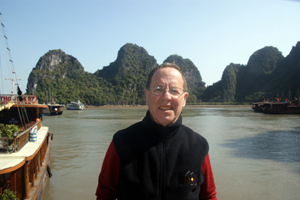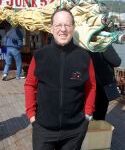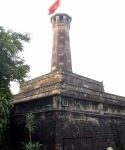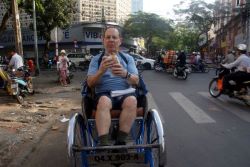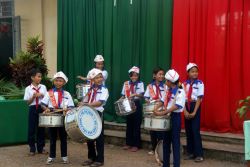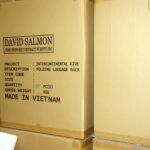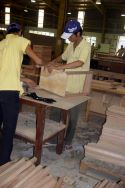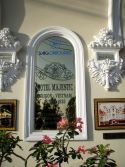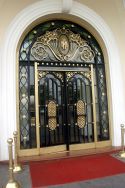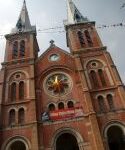Let me combine two thoughts for my last blog entry. One involves the new “Tet Offensive.” In 1968, the Viet Cong mounted the “Tet Offensive.” Set to coincide with the Lunar New Year (“Tet”), the 1968 version assaulted the major U.S. bases, including the U.S. embassy, which was occupied in the middle of Saigon. Amid U.S. claims that we were “winning the war,” the Tet offensive caused a rethinking of the support in the U.S. for continuing the war, and ultimately led to our stating, “We won,” going home, and in 1975 watching the North Vietnamese tanks breach the Presidential Palace (now known as the Reunification Palace).

 Today’s “New Tet Offensive” is mounted by marketers on an increasingly wealthy population. 35% of the urban population is thought to be “middle class,” officially making the $350 a month that is classified as the entrance into the middle-class level. The Tet holiday, about to start, is a 10-day (or two-week) celebration of the Lunar New Year. Children return home to spend time with family, the nucleus of a Confucian society. You may remember last year a massive snowstorm crippled China during Tet and left millions stranded. Gifting is important.
Today’s “New Tet Offensive” is mounted by marketers on an increasingly wealthy population. 35% of the urban population is thought to be “middle class,” officially making the $350 a month that is classified as the entrance into the middle-class level. The Tet holiday, about to start, is a 10-day (or two-week) celebration of the Lunar New Year. Children return home to spend time with family, the nucleus of a Confucian society. You may remember last year a massive snowstorm crippled China during Tet and left millions stranded. Gifting is important.
Here, where the poverty level is officially 13%, down from some 40% a decade earlier, people are preparing for Tet. The stores are decorated, 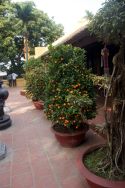 as are homes. Most pronounced here are kumquat trees, with an orange/tangerine-sized fruit. The airlines have put on 30 extra flights, the trains have added extra trips, etc.
as are homes. Most pronounced here are kumquat trees, with an orange/tangerine-sized fruit. The airlines have put on 30 extra flights, the trains have added extra trips, etc.
One important (recent) addition is the return of the overseas Vietnamese. Once denounced as traitors, the Viet Kieh are now welcomed as part of the effort to modernize the country. In fact, quite recently the government allowed foreigners to own land (for 50 years) under specific conditions. The overseas Vietnamese have been important for a long time; I remember in 1995 when I was here, I learned that the Viet Kieh remittances were instrumental in supplementing income and allowing people to buy motorbikes which they could not do on their local salaries. The Overseas Vietnamese are numerous. Many fled the Communist regime during the war or after 1975 and settled in the United States. I learned last night there were 4,000 Vietnamese in Lincoln, Nebraska!
It’s really neat being here close to the Lunar New Year, and I realized I’ve never been in Asia this close to the New Year before. It has become a marketer’s paradise. One of our speakers just described the consumer – materialism, conspicuous consumption, and individualism that are rampant (We won? Can Wal-Mart be far behind?)
As for Confucius, I read an interesting book several years ago, entitled, “Confucius lives next door.” The book described the persistence of Confucian thought in Japan. It’s true here, too. There’s one Confucian saying that I’d like to address in the rest of this blog: It is a pleasure to welcome guests from afar. That’s certainly true for my experiences in Vietnam, which students at IWU, who are Vietnamese, enhanced by welcoming me, either in person, or through their parents. They let me meet people who are locals, not viewed from the bus.
One of current students told me, “My parents want to meet you.” When I called the father, on Sunday, he told me to phone him when I was done with my tour and he’d come meet me. He picked me up and we went to Hoa Kiem Lake, the center of the old city, for tea. He’s a government official (assistant to the Prime Minister of Vietnam) with a master’s degree in economics from Williams College, a Ph.D. in econ from Hanoi National (where he’s taught) and a Fulbright Post Doc at Johns Hopkins in Washington. We wandered around the city, had dinner at a quiet Vietnamese restaurant (without foreigners!), and I told him I’d like to see the water puppet show, which I’d remembered as one of the great entertainments the two times I’ve been in Vietnam before. He bought two tickets, but admitted he’d seen the show hundreds of times before and did not need to see it again. He did, however, bring me back to the hotel, where I found a faculty member who wanted to see it, then drove us, waited, and took us back.” You don’t need to do this,” I suggested, knowing that as his son’s teacher, I would merit the attention.
The following day, he invited me back to have dinner at his house with his family. He explained that his “family” (extended) had combined to “invest” in my student’s American education (as his father and uncle had gone to school in the U.S., their sons would have to do so or lose face). His daughter, he proudly told me, had placed second in the English competition for 5th graders in Hanoi. After dinner, she absented herself “because it is a school night and I have homework to do.”
Last night he asked if I would meet his mother, who lives with a younger brother along West Lake, not far from here. I did so, and met a young man who would like to go to the States to study (as father and uncle had). Interestingly, the uncle, being of the right generation, had studied in Prague, when Vietnam was an Iron Curtain country. Dad is arranging for a driver to get me to the airport, and had lunch with me this afternoon and left his brother to make sure I saw the two temples near here that were high on my list of things to do. The temples date from the 11th century and the founding of Hanoi. Teacher, and elder, and guest from afar – a powerful combination in a Confucian world, as the next example also illustrates.
Last night a December graduate of IWU from Hanoi who was home awaiting his departure for graduate school at the University of Nebraska picked me up on his motorcycle and asked, “What kind of food?” I said, “Vietnamese of course,” and off we sped, like locals, to a restaurant  where he introduced me to his girlfriend (a student at UN – I see the picture perfectly); the three of us sampled a variety of the local cuisine, including some dishes I’d not had before (Vietnamese food is quite varied – lots of seafood and noodles; the primary noodle is called pho, pronounced roughly fuh – and quite good).
where he introduced me to his girlfriend (a student at UN – I see the picture perfectly); the three of us sampled a variety of the local cuisine, including some dishes I’d not had before (Vietnamese food is quite varied – lots of seafood and noodles; the primary noodle is called pho, pronounced roughly fuh – and quite good).
On the way back, he offered a tour of the old city. Motorcycles zoom in and out where cars fear to tread (or are blocked), so it was quite an exciting ride. My colleagues were impressed that I’d been able to do it – and survive. We have a farewell banquet tonight, which I leave for departure to Narita in Tokyo, then to Dallas and then home. As always, I’m Hanoied at having to leave, but it will be good to get home and think about coming back to Asia in May.
Yi lu ping an, as we say in Chinese. A peaceful journey – and chuc mung nam moi. Happy New Year. And congratulations to my new and old Vietnamese friends on the New Tet offensive.
